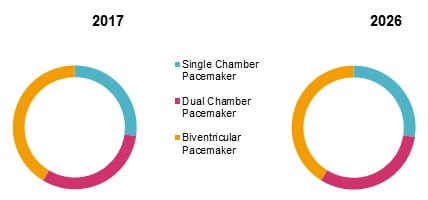Global Implantable Cardiac Pacemaker Market – Global Industry Insights
Since the evolution of implantable cardiac pacemakers, cardiac pacing devices are extensively used to treat bradycardia (delayed or absent activation of the entire ventricle) and Cardiac Resynchronization Therapy (CRT). Implantable cardiac pacemakers are the small devices, which are placed inside the chest or abdomen in order to control abnormal heart rhythms. Pacemakers are also majorly used to treat arrhythmias: a problem with the rate of rhythm of heartbeat, in which heart beats too fast and sometimes beats too slowly causing irregular rhythm.
Several market players in emerging economies such as Asia and Middle East are offering products with comparable performance levels to that of high-end implantable cardiac pacemakers at affordable costs. This is mainly attributed to factors such as increasing availability of skilled physicians and healthcare practitioners, lower costs incurred with medical facilities, and combined efforts of government and domestic players to increase patient access. Moreover, increasing prevalence of cardiovascular disease such as arrhythmia, atrial fibrillation, long QT syndrome, bradycardia, and tachycardia coupled with adoption of sedentary and unhealthy lifestyle are further expected to augment growth of implantable cardiac pacemaker market over the forecast period
The global implantable cardiac pacemaker market was valued at US$ 4.7 billion in 2017 and is expected to witness a CAGR of 7.1% over the forecast period (2018 – 2026).
Global Implantable Cardiac Pacemaker Market Share, By Product Type: 2017 & 2026

To learn more about this report, Download Free Sample
Source: Coherent Market Insights Analysis (2018)
Introduction of Advanced Pacemaker Technologies is Expected to Drive Growth of the Implantable Cardiac Pacemaker Market
Adoption of advanced technologies in cardiac pacemakers such as MRI safe-pacemakers, pacemakers with improved battery life, delay the progression of persistent Atrial Fibrillation (AF) in patients suffering from bradycardia and wireless automated technologies. This advancements are gaining significant traction of various market players of implantable cardiac pacemakers with affordable costs, which in turn are expected to drive growth of implantable cardiac pacemakers market. For instance, in February 2017, Abbott received the Food and Drug Administration (FDA) approval for its MR-conditional labeling for both of its products i.e. Assurity MRI pacemaker and the Tendril MRI pacing lead. Furthermore, introduction of advance technology such as wireless and automated pacemaker monitoring pacemakers are gaining significant traction among healthcare providers.
For instance, in 2016, Biotronik launched CardioMessenger Smart, portable monitoring device in the U.S. This system is about the size of a modern smartphone used to keep pacemaker, Implantable Cardioverter Defibrillator (ICD) and Insertable Cardiac Monitor (ICM) patients connected to their physician remotely. This CardioMessenger Smart helps to ensure patient compliance and the consistent transmission of data necessary for physicians to identify and prevent potential cardiac events. Thus, such wireless technologies are gaining traction of vendors, which is expected to drive the growth of the implantable cardiac pacemaker market
Increasing Prevalence of Cardiovascular Disease is Expected to Drive Growth of Implantable Cardiac Pacemaker Market
Increasing incidence of cardiovascular diseases is expected to boost growth of the implantable cardiac pacemakers market over the forecast period. According to the Centers for Disease Control and Prevention (CDC), August 2017 data findings, Atrial Fibrillation (AFib or AF) is most common type of heart arrhythmia, which affected an estimated 2.7 to 6.1 million people in the U.S. and the number is expected to increase in near future. Furthermore, Atrial Fibrillation cases increase with age and it is more prominent in men than women. Moreover, increasing number of geriatric population across the various regions worldwide along with high prevalence of heart disease is expected to propel demand for implantable cardiac pacemakers in the near future.
Furthermore, according to the data published in the Journal of the Formosan Medical Association, in November 2016, around half of the world population is living in Asia and geriatric population is growing at faster rate in Asia, which is increasing burden of AF in Asia. According to the same source, in 2050, around 72 million people are projected to suffer from AF patients in Asia, which is expected to be more than double the combined numbers of patients from Europe and the U.S. Furthermore, according to the World Health Organization (WHO), in 2015, around 17.7 million deaths were recorded due to cardiovascular diseases, out of which around 7.4 million deaths were caused due to coronary heart disease and 6.7 million deaths due to stroke. Furthermore, according to the American College of Cardiology, as of 2017, cardiovascular diseases accounts for around 800,000 deaths in the U.S and it remains the leading cause of death in the U.S.
However, implantable pacemakers associated infections in cardiac patients is hindering growth of the implantable cardiac pacemaker market. Pacemaker surgery is associated with swelling, bruising, bleeding, or infection of the area where the pacemaker was placed leading to blood vessel or nerve damage and adverse reaction of medicine used during the pacemaker implantation surgery, which may reduce the adoption of implantable cardiac implants in patients.
Some of the key players operating in implantable cardiac pacemaker market include Medtronic plc, BIOTRONIK, Inc., Boston Scientific Corporation, St. Jude Medical, Vitatron Holding B.V., Shree Pacetronix Ltd., MEDICO S.p.A., Lepu Medical Technology Co Ltd., LivaNova PLC, and Qinming Medical.
Share
Share
Missing comfort of reading report in your local language? Find your preferred language :
Transform your Strategy with Exclusive Trending Reports :
Frequently Asked Questions
Select a License Type
Joining thousands of companies around the world committed to making the Excellent Business Solutions.
View All Our Clients